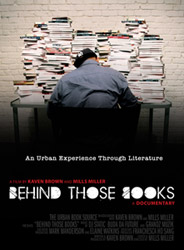I recently posted and interesting trailer for a documentary about Urban Fiction called Behind Those Books. I was unable to attend the premiere in New York City, but a dear friend and author Kaira Denee (My Husband’s Fiancée, Sugar’s Daddy, and Take it There) was able to attend and give her review on the documentary to share with my readers.
Those, them, they… pronouns sometimes snidely used to separate something or someone from the majority. “Behind Those Books” explores the backlash that urban fiction receives many times from its target audience and surprisingly from the very people that paved the way for this genre to flourish.
My generation grew up reading the likes of the legendary Judy Blume and R.L. Stine. While these novels were wonderfully entertaining, none of them spoke to the plight that is unique to the African-American experience. The ‘90’s gave birth to a new kind of fiction – later dubbed “urban fiction” – that resonated in the hearts of African- American readers. Terry McMillan, Eric Jerome Dickey, and Bebe Moore Campbell were some of the most popular authors of the genre to make mainstream headlines.
Like any genre, urban fiction is multifaceted and it’s the more gritty or ghetto stories that receive the most flack. The trailblazers of urban fiction are some of the most vocal in bashing the grittier style of fiction. Iceburg Slim and Donald Goines were among the first authors to write from this angle and although they sold lots of books and gained popularity, during their time period their style of writing was still very taboo. The emergence of urban fiction in the ‘90’s finally turned the spotlight to grittier writers like Sista Souljah and Omar Tyree, whose stories were quickly relatable to members of society that hadn’t often been written about.
Urban fiction is scrutinized by some because of its content that oftentimes includes stories of crime, drug addiction, graphic sex and violence. Critics say urban fiction authors are “dumbing down” and exploiting its own people for profit or glorification. What producer Kaven Brown and director Mills Miller communicated in their film is – what’s so new about this? It’s no secret that many of the most popular movies (be it targeted to African Americans or otherwise) are filled with sex, corruption and murder. “Behind Those Books” cited Goodfellas, Training Day, The Godfather and Scarface as prime examples of gratuitous displays of violence, drugs and crime. Yet these films have won numerous awards and made hundreds of millions of dollars. Is Urban Fiction more offensive because it’s the written word vs. a motion picture? Is Urban Fiction more offensive because it’s told by people that often lived the lives they’re writing about vs. Hollywood executives?
My favorite and most poignant line from the film is by bestselling urban author, Treasure Blue. “I’m from Harlem. I am an abandoned child. My mother was a whore. And the things I saw through these eyes, no child should have had to witness or experience. So am I wrong for writing about my life that I saw?”
The main takeaway from the “Behind Those Books” documentary is: Behind those books are capable, motivated, tormented, hustling, creative individuals determined to tell their stories, their way.



Leave a Reply